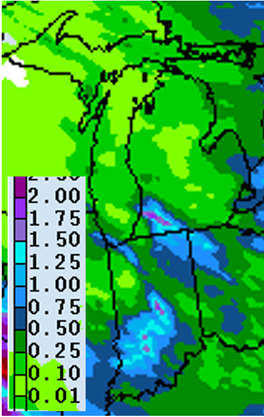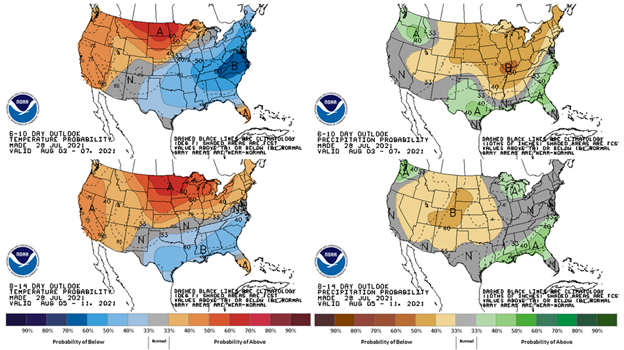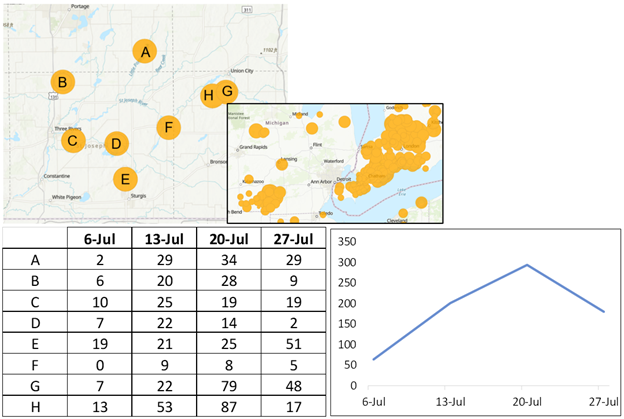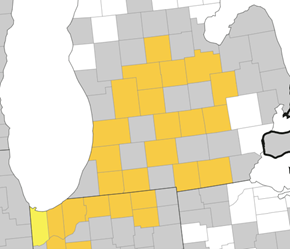Southwest Michigan field crops update – July 29, 2021
Cooler temperatures expected this coming week will be a welcome change as much of the corn crop in the region is undergoing pollination.

Weather
Temperatures this past week were only a few degrees warmer than normal along the western edge of the region and close to normal for the rest of us. We are still nearly 100 growing degree days (GDD) base 50 ahead of normal as measured since May 1. A deep upper-air trough is forming above eastern Canada and the Great Lakes region, which will be bringing cooler than normal temperatures to Michigan through at least the middle of next week with highs in the mid- to upper 70s. The forecasted reference evapotranspiration (FRET) for the coming week is normal for this time of year at roughly 1.2–1.3 inches of water. The 6-10 day forecast reflects this cooling pattern, but a return to warmer-than-normal temperatures is predicted by the second week of August.
Precipitation this past week ranged from well below normal in some parts of the region to as much as three times the normal amount in a northwest-to-southeast band and along the eastern edge. Soil moisture levels are near normal on the whole (as measured by satellite) but will obviously be affected by soil type and field-specific rainfall totals. The rainfall forecast for the coming week is for up to 1.5 inches for some parts of the region. However, most of that prediction is based on heavy rainfall today (July 29). With diminishing chances of rain as the day progresses, it is unlikely most of us will receive even half that amount. We could see as much as a quarter of an inch over the weekend, but no rain is predicted for next week with the high pressure center lingering over Michigan. The 6-10 day outlook calls for below-normal precipitation with no strong guidance after that.



Crops and pests
Corn in the region ranges from pre-tassel to R2 (blister). Early planted soybean has reached full pod (R4, 0.75-inch pod at one of top four nodes) while most fields are still in beginning pod stage (R3, 0.1875-inch pod at one of top four nodes). Both crops will require roughly 1.40-1.55 inches of water this coming week. With the variable rainfall totals over the region for the last couple of weeks, soil moisture levels can be quite different from field to field. We have seen signs of moisture stress in both corn and soybeans in some locations this past week. The rainfall from the expected severe thunderstorms forecasted for last night (July 28-29) was also quite variable, so if you are irrigating, check the rain gauge and make your plans accordingly. Some fields will be undergoing the first significant moisture stress that they have seen since mid-June.
As these conditions change, growers may want to keep an eye out for our dry weather pests to begin to show up in fields. Although we have not seen significant numbers of spider mites and soybean aphids this season, drier conditions can help provide them a foothold for establishment.
Western bean cutworm moth counts were still high this past week. Without knowing what the coming weeks will bring, it appears the peak flight in our region may have been last week. For those who still have pre-tassel or early tassel corn, remember when scouting that thresholds are cumulative—check 20 plants at five different locations in the field and count the number of plants with egg masses. The treatment threshold is 5% of plants with egg masses, but if you found, for example, 2% last week and 3% this week, you have reached threshold.
Remember, western bean cutworm populations have been widely confirmed in the past couple of years as being resistant to the Cry1F Bt toxin, so assume your corn is unprotected against western bean cutworm unless you have Syngenta’s Viptera trait (Vip 3a protein). For those who had pre-tassel corn sometime over the past few weeks, recall that eggs hatch in five to seven days and larvae begin traveling to find pollen to feed on. If you reached threshold during your scouting, insecticides should be applied before the advanced-stage larvae begin burrowing into ears.

Corn tar spot initial infections were found in early July in portions of Van Buren County. These initial lesions presumably have had enough time to begin producing spores, which over the last couple of years has marked the time that we begin to see more tar spot in fields. With the expected cooler and drier conditions over the next week, we might catch a bit of a break in terms of disease spread on dryland fields. However, on irrigated fields, we should be aware that finding times of the day to apply water that minimize the overall period of leaf wetness can reduce the risk of tar spot infection that we have seen over the last several years.
You can review Michigan State University Extension field crops pathologist Marty Chilvers’ discussion of Tar Spot Under Irrigation from the MSU Irrigation webinar video. You can also watch Chilvers’ presentation on Tar Spot and White Mold Management Options from the MSU Extension Field Crops Virtual Breakfast website. In short, leaf wetness durations over 7 hours can increase the spread of tar spot in irrigated fields. Remember, as we move into August, we can start to see an increase of the foggy morning dews that can lead to more risk for dryland fields as well. We have seen the most significant increase of visible tar spot lesions during the mid- to late-August period, but the infection period for these lesions undoubtably was in late July and early August.

Weeds
August is the perfect time to begin to evaluate your weed management programs. Note any weed pockets in fields that have shown up and investigate what species they are. Look for species that are new to your operation and come up with a strategy of how to keep from spreading them across your fields. Be especially aware of pigweeds (most likely common waterhemp or Palmer amaranth) that didn’t die and giant ragweed. Some fields in eastern Branch and Hillsdale counties visited last week almost certainly had glyphosate-resistant giant ragweed based on the prevalence.
Unfortunately, sometimes it is more cost effective for your operation to go into the fields and remove new pockets of plants before they spread seed. Johnsongrass, Palmer and waterhemp that start out as a small pocket can take off and become very expensive to control in just one to two years. The best first strategy is to control with an effective herbicide or remove the plants before they produce seed. The best second strategy is to avoid harvesting these areas until last and clean out the combine thoroughly. These approaches tend to stave off the worst of the problem for a while, but usually a more rigorous (and expensive) herbicide program will be in your future.
Don’t be shy about pointing out problem areas to your neighbors in their fields as well. These problem weeds do not respect field boundaries, so their problem can quickly become yours.
Irrigation
Join us for the MSU Irrigation Webinar on Aug. 4 where the topics of irrigating fruit crops, water supply requirement estimates, and leaf wetness and disease prediction will be discussed. Cost is free, register online to receive the link which will be used for all episodes in the series that air every other Wednesday through Sept. 15.



 Print
Print Email
Email